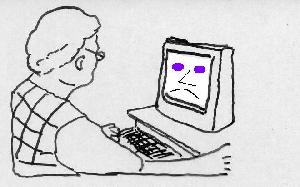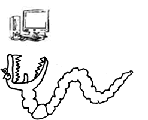|
|
|||
|
|
|||
|
Outside Computer Links |
|||
|
|
|||
|
|
|||
|
Outside Computer Links |
|||
| Internet Threats Be Aware of Threats to Your Computer |
 |
The good news is that the Internet has become a resource to enrich all of our lives. Google and Yahoo are at our fingertips to find any information in a flash. We can social network also in an instant, keep in constant touch no matter how far we are from each other through email, download useful software, download music and podcasts, keep up on the news through access to any newpaper around the world, and otherwise pursue your heartís desire. |
|
The bad news is that the Internet can be dangerous territory. If you never use a computer to log on to the Internet, you donít have to worry about your computer getting malware that could literally bring it to a stop or slow it down to turtle-speed no matter how good the hardware is. Spyware and Viruses: First Step: Know the Enemy |
 |
One category of malware-(nasty stuff)- are the viruses. Their basically little programs but not for your benefit but to cause damage or some mischief. There are many kinds of viruses and some are worse than others; also some are more wide-spread -and the two factors donít always correlate. A virus can have a low damage level but be widespread (in the wild) and vice-versa, a virus can have a high damage level but be |
|
very limited in spread. Fortunately, no virus has really had high damage and
been wide-spread or it would be the Chernobyl of all viruses. |
 |
Then came worms. They could spread across networks and could spread without human help. They mainly arrived in your inbox as attachments at first. Open the attachment, and your computer is infected and these worms could use your email to spread to all of your friends! Worms could also spread through instant messaging and chat or sharing music through peer-to-peer networks. Later, worms got fancier and could open without needing attachments after |
| arriving in your email. Then, some worms could spread over networks and when
you were on the Internet (which is the largest network), through holes in the
coding of an operating system. Worms spread so much to computers world-wide,
that their names are known to all: SoBig, MyDoom, Melissa, Love Bug,
Bugbear, Blaster, and Code Red among many others. Another nefarious virus is the Trojan or Trojan Horse virus. Just like the famous Trojan Horse of Greek myth, they come in disguise. Trojans can seem to be a useful program at first or tag along with perhaps a free program you download. The Trojans will stay hidden on your machine and can be hard to ferret out. I have seen machines with the usual antivirus on them, but when running another program to detect malware, Iíve found a Trojan missed by the main anti-virus program. Trojan Horse viruses hide away while carrying out their misdeeds such as sending your data out, taking over your computer, and bringing spyware and even more malware to your computer. Trojans can be the means that cyber criminals use to get access to your computer.Theyíre not good. Lately, a new type of malware is widely seen, spyware and adware. They usually donít directly damage your computer but they can pop up ads at you, spy on you and send your data outside. Often companies will add their spyware or adware to a free program you would like to download. They often feel that this is the price you should pay to have the privilege of using their software without paying. The recipient of the adware/spyware usually would not share this viewpoint. Spyware will often arrive as a conjoined twin with a Trojan or spyware will often open the door and put out a red carpet invitation for Trojan Horse viruses to come to your computer-not a pleasant prospect. To get a concept of how many viruses, spyware, and adware are out there (and new ones arrive every day so you need to update your antivirus all of the time), take a look at Symantecís Virus encyclopedia: http://www.symantec.com/enterprise/security_response/threatexplorer/azlisting.jsp |
|
The Weapons |
 |
Weapons are needed in the battle against malware that can come to your computer. The basic weapons you should have on your computer are a good anti-virus program, and a very good comprehensive security program or a combination of different programs that remove spyware and adware. I like some free programs like "Spybot Search and Destroy" and "Ad-Aware" (these will remove spyware/ adware but not block |
| them from getting on your computer) -and free "Windows Defender" which can be used with Windows XP, Service Pack 2. Also keeping your system updated with patches from Microsoft through Windows Update needs to be done to close holes that can be used by malware to infect your computer. |
| Updating |
|
Defending your computer against malware is very necessary, but,
unfortunately, not a no-brainer. You have to give some real consideration to
picking the right programs to protect your computer. |
|
The Defenders |
|
Norton products
(www.symantec.com) and
McAfee antivirus and security products
http://www.mcafee.com/us/ are the gold standard for protecting
your computer. There are problems involved with these programs, however, in
that they can be very demanding on the resources of your computer and can
slow down your computer quite a bit and cause freezing especially if you
have an older computer. Also, the protection does not come cheap-either for
the initial product or the updating of the definitions yearly (renewing the
subscription). |